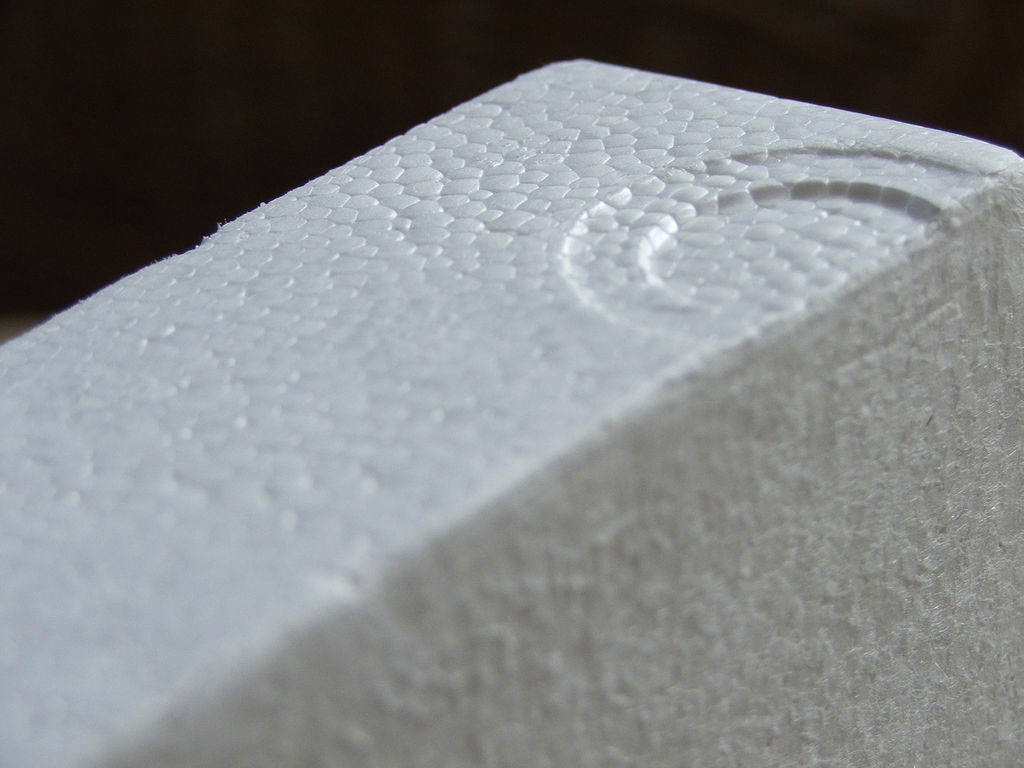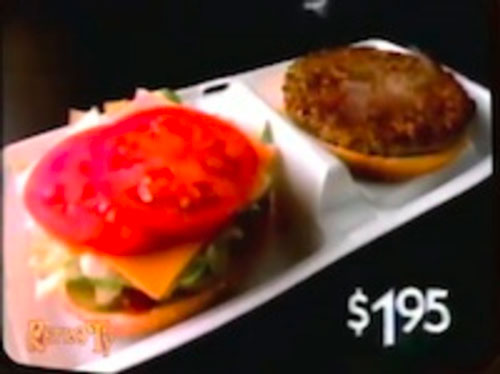It’s Not Styrofoam
Once seen as an incredibly innovative, lightweight material, expanded polystyrene foam is now just a big problem—in part because it’s so hard to recycle.
1941
The year that Dow Chemical engineer Ray McIntire discovered the process of making Styrofoam, which he did by accident. Mcintyre was hoping to create a more rubber-like substance when he combined polystyrene and isobutylene, but the discovery proved incredibly important anyway, immediately getting used during World War II. He didn’t discover polystyrene, which came about in the 1800s (also an accident), and Swedish inventor Carl Georg Munters beat McIntire to the punch on the discovery front, but Dow turned it into a household name.

This material is not Styrofoam. Don't let anyone tell you differently. (Björn Láczay/Flickr)
What’s the difference between styrofoam and polystyrene, anyway?
It really sticks in the craw of Dow Chemical that we call foam food containers “Styrofoam,” despite the fact that Dow has trademarked that name for more than 60 years.
In a 2013 Washington Post article, Dow’s business director for building solutions in the Americas, Tim Lacey, sounded like he was at the end of his foam-laced rope.
“We’re doing everything we can to make sure that it’s used properly,” Lacey explained. “We don’t really know why everyone wants to land on the name Styrofoam, and why it serves as something people want to misuse.”
That’s because, when you’re using a cup, plate, or other material, you’re using a material that’s actually called expanded polystyrene. And as Dow Chemical and Owens Corning, the two primary manufacturers of extruded polystyrene, will tell you, it’s not a small or modest difference.
In a lot of ways, the process used to make a cup, versus building insulation (the primary modern use of extruded polystyrene) is the difference between a million pieces of foam and a solid brick. The cup you grabbed from the Shell station? That’s built using a molding process, in which relatively malleable balls of polymer are pressed into a specific shape after those polymers have been filled with gas. (Larger balls might be used for coffee cups, smaller ones for foam trays.)
As a result, there’s a lot of air in there, which makes the cup lightweight and flexible, while still gaining the insulation advantages that come with foam.
The problem is, there are cases where you can live with a little more weight and a little less flexibility, because you want the resulting material to be a lot stronger. That’s where the extrusion process comes in.
A good way to explain this is to go back to the way cheese curls are made, because those also use an extrusion process, except with flakes of corn instead of polymers of styrene oil. But there are some differences, however: You want air in your cheesy poofs, so you pop them straight out after they’re ready to puff up.
But let’s say you want to extrude something that was more crisp, closer to a tortilla chip than a Cheeto. You’d have to figure out a way to more tightly control how the extrusion process manages air to achieve more concentrated results. With Styrofoam, the extrusion process is managed in this way, designed to minimize the amount of air that gets through the material, so as to make the material very tough.
The result of this is that the material you get with extruders is designed for longer-term uses, like in houses. This clip from Owens Corning does a good job explaining why extrusion is desirable in the case of building materials: Simply, it’s tougher, because there’s less air than you’d find in expanded polystyrene. Because there’s less air, it’s very difficult for water to seep in through such material.
Building materials are meant to hold up for decades or longer. Single serving food? It only has to hold up as long as your delivery driver takes to get the Ethiopian food delivered to your door without the driver getting tsebhi birsen all over their vehicle.
The problem is, of course, it lasts a lot longer than that.
“The possibilities for various creations of Styrofoam, in its many shapes and sizes, are unlimited. It is our intent to offer suggestions for a variety of exciting experiences with this medium as an art form, to whet the appetite of the reader to create and to stir his imagination to devise and find his own mode of expression.”
— A passage from Creating with Styrofoam and Related Materials, a 1970 book for children that discusses the possibilities for using polystyrene in crafting—particularly by recycling used meat trays, packing materials, and other and turning them into works of art. After World War II, crafting and decoration were actually original uses for Styrofoam, particularly around Christmas.

The McDLT, once Jason Alexander's meal ticket.
Five Interesting Facts About Polystyrene Packaging
- In 1960, the Dart Manufacturing Company shipped its first order of disposable cups using the expandable polystyrene. The company, soon renamed the Dart Container Corporation, quickly grew to dominate the food service packaging industry.
- Starbucks’ decision to eschew foam cups in favor of paper ones was a functional, rather than environmental, decision. According to Bon Appétit, the company—as it was evolving into its current form as a retail chain—decided to use the paper cups because its cup supplier, Solo, only made the domed lids designed to protect froth for its paper cups. In other words, Starbucks got rid of one kind of foam to protect another.
- Environmental complaints about foam food packaging have been long-running, with McDonald’s an early target of such complaints, particularly due to the McDLT, a burger that used polystyrene to separate the veggies from the meat and gave Jason Alexander an early acting gig. The chain, facing pressure from the Environmental Defense Fund, gave up the foam packaging in the early ‘90s.
- A first-mover on banning foam containers, as you may possibly guess, is Berkeley, California, which banned both foam cups and foam food containers in the late ‘80s. "Berkeley alone doing this is not that significant," noted Berkeley City Councilwoman Nancy Skinner, “but if we do it and it causes other cities to do it, and causes companies to change things, that's significant.”
- Polystyrene packaging made it possible to ship high quality meats through delivery services like UPS. In a 1985 issue of Kiplinger’s Personal Finance, associate editor Dan Moreau, who was tasked with reviewing a wide variety of mail-order foods, noted that his Omaha Steaks weren’t any worse for wear despite the long gestation process. “The steaks and flounder came in a two-inch-thick foam plastic carton with dry ice and were still frozen rock hard even though they were shipped through regular UPS service and took several days to arrive,” Moreau noted. You should buy it for the packaging, obviously.
The thing with polystyrene is that, even with all the environmental costs that come with it—one 2007 protest in New York City, led by an up-and-coming city councilman named Bill de Blasio, pointed out that the city’s schools were at that point throwing away 4 million polystyrene trays per week—is a massive business, and one that companies like Dart Container Corporation want to do everything they can to protect.
(Dart has been setting up recycling centers all over the country for this reason, which should offer hints about exactly how big its business is.)
Expanded polystyrene in particular is horribly expensive to recycle, in part because of the very benefits that make it so attractive in the first place—because the material is 95 percent air, it’s incredibly bulky, and converting it back to its original form is challenging. Essentially, you’re trying to put a genie back into a bottle.
One attempt that’s been gaining attention in the Canadian market is a service called Polystyvert, which solves the problem of recycling polystyrene by putting a machine that recycles the plastic on the premises of a firm that uses a lot of polystyrene—solving the problem of transporting it. The machine then dissolves the material using essential oils, and separates out the polystyrene so it can be used again for packaging.
It’s still a relatively new concept, but the Montreal-based business has already raised a significant amount of funding.
There’s a lot of polystyrene out there—just think of how many people order Grubhub on a given night, and in towns where a foam packaging ban isn’t even on the radar. It’s daunting, but efforts like Polystyvert could someday make a big dent.
:format(jpeg)/2017/03/tedium031417.gif)
/2017/03/tedium031417.gif)

/uploads/ernie_crop.jpg)